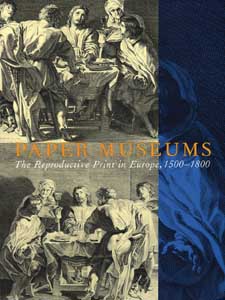Art imitates art: Reproductive prints took museum to public
By Jennifer CarnigNews Office
 The catalog cover for the “Paper Museums” exhibition features the print Supper at Emmaus, 1611, Willem Swanenburg after Peter Paul Rubens | |
Imagine a time when it was impossible to see the baby blues and pinks of Michelangelo’s frescoes in the Sistine Chapel or the lifelike curves of Raphael’s statue of Ariadne. In an age when people send digital pictures over cellular phones and when the Internet offers instant access to museum collections around the world, it is difficult to fathom an age when art was unavailable to the masses.
Though the printing press may seem like ancient history, it was not too long ago that its creation brought masterpieces to the mainstream. Long before the advent of photography, a variety of print techniques already had revolutionized the ways in which images could be reproduced and circulated in Renaissance and Baroque Europe. Reproductive prints—prints based on other works of art—allowed a broad public to become familiar with paintings, sculptures and frescoes that previously had been private, available only to wealthy travelers or collectors.
In “Paper Museums: The Reproductive Print in Europe, 1500-1800,” the newest installation at the University’s Smart Museum of Art, the print is studied for its impact on the art world and society at large, and as art in itself.
This unique retrospective includes prints by or of Dürer, Claude Lorrain, Raphael, Watteau and J.M.W. Turner, among other artists, while also highlighting recent Smart acquisitions, such as an engraving of Michelangelo’s Last Judgment and two prints of Rubens’ Supper at Emmaus. Far from being “merely reproductive,” these prints are themselves objects of beauty and worthy of study, said Rebecca Zorach, co-curator of the exhibition and Assistant Professor in Art History and the College.
“I wanted to move beyond the distinction made between reproductive prints and original prints,” said Zorach, who spent two and a half years working on the project and who currently is teaching an undergraduate class on the ideas behind the show. Even when the duplication of an image was precise, Zorach said, every time an artist produced a print and every time it saw a new audience, new layers of meaning were created that may have altered the original’s significance or function. “This is an under-acknowledged site of creativity and impact.”
Zorach, whose research focuses primarily on French and Italian late-medieval and Renaissance art, said print artists always had to alter the original image in some way. They did everything from changing the primary artwork for the sake of legibility—it is difficult to translate color into a black-and-white medium—to altering the original work by eliminating or adding characters or background. In effect, they created new works of art by reproducing another artist’s creation.
In addition to their creative contributions, reproductive prints cannot be overvalued because of the sheer impact their quantity and distribution had on the art world, noted Zorach. Prints allowed art to be seen, she added. Frescoes could not be moved, so for one to see Leonardo’s Last Supper or Raphael’s School of Athens, one had to travel to the site of the artwork. Reproductive prints built artists’ reputations, often bringing fame, and they allowed artists to refer to and even critique each other’s work in a way that was previously difficult.
The exhibition in some ways “demystifies the idea of artistic genius,” Zorach said. “Lots of artists have always utilized the ideas of other artists. The reproductive print just made it easier to do.”
“Paper Museums” will travel to New York University’s Grey Art Gallery, following its exhibition at the Smart Museum of Art. Elizabeth Rodini, a lecturer in the history of art at the Johns Hopkins University and a former Smart Museum Mellon Projects Curator, co-curated the exhibition with Zorach.
“Paper Museums” can be seen through Sunday, May 15, at the Smart Museum of Art, 5550 S. Greenwood Ave. Admission is free. Call (773) 702-0200 or visit http://smartmuseum.uchicago.edu for more information.
There also will be a two-day symposium co-organized by the Smart Museum and the Art Institute of Chicago that will further develop and expand on the issues raised in the show. The symposia’s keynote address on Friday, April 1, by Peter Parshall, curator of old master prints at the National Gallery of Art, will be followed by a series of slide talks Saturday, April 2, by top scholars and curators. For more information and registration, call (773) 834-1210 or visit http://smartmuseum.uchicago.edu/papermuseums.
![[Chronicle]](/images/sidebar_header_oct06.gif)